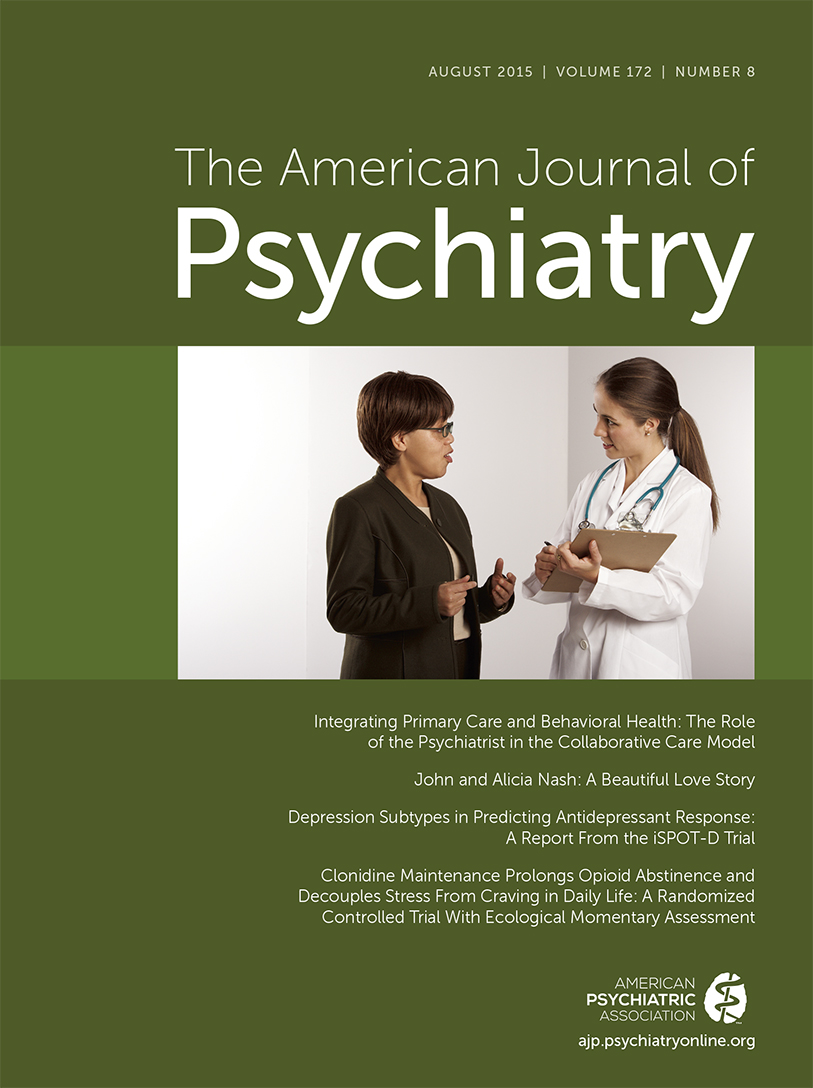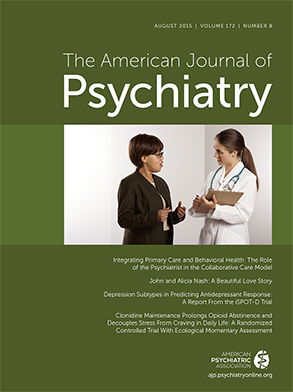Defining how interactions between an individual’s genotype and environment (“gene-by environment”) act upon the brain to result in mental illness is a vital but challenging endeavor. The study by van der Meer et al. (
1) in this issue of the
Journal takes one of the most widely studied of all gene-by environment interactions into the brain in an effort to map out neural pathways to attention deficit hyperactivity disorder (ADHD).
The “gene” under study is a genetic variant, a variable number tandem repeat polymorphism, in the promoter region of the serotonin transporter referred to as
5-HTTLPR. It has a short (“
S”-allele) and a long (“L”-allele) form, and the variation affects serotonergic signaling (
2). The “environment” is an amalgam of chronic social stressors and major adverse life events. It has been reported that carriers of the short,
S-allele are more vulnerable to depression when exposed to adverse events (
3–
6). Here, the authors find that the same gene-by-environment interaction may extend to ADHD. They show that young adults with one or two copies of the
S-allele when exposed to social stressors have more symptoms of ADHD than those with two copies of the L
-allele. They proceed to ask why and look to the brain for an answer.
The study’s sample is enriched for ADHD, with 291 young, affected adults, 78 individuals with subthreshold ADHD, and 332 healthy comparison subjects; many of the participants were siblings. All had magnetic resonance neuroanatomic scans to allow the definition of gray matter volume with an exquisite level of spatial resolution (around half-a-million voxels, or tiny “volumes”). The authors ask whether change in brain structure is the mechanism through which the 5-HTTLPR/stress interaction affects the severity of ADHD symptoms. Mediation analyses are widely used in mapping such possible causal chains. The authors start by defining a term that reflects the interaction of the gene and stressful environments. They show that this term is significantly associated with the volume of several prefrontal cortical regions. Next, they find that some of these prefrontal regions are further associated with the severity of ADHD symptoms. Combined, this demonstrates that variation in prefrontal cortical structure mediates, or statistically accounts for, the stronger correlation seen in S-allele carriers between social stress and ADHD symptoms. Specifically, decreased volumes of the left frontal pole and right anterior cingulate cortex emerge as possible contributors to the increased ADHD symptom severity seen in S-allele carriers when exposed to stress.
It has been intensely debated whether this interaction between
5-HTTLPR and social stress plays a role in altering risk for psychopathology. Most studies have examined vulnerability to depression with meta-analytic evidence both for and against a link (
4–
6). The proposal by van der Meer et al. that this gene-by-environment interaction is also linked to ADHD is much less studied. One prior study of 110 adults with ADHD found that the L
-allele (but not the
S-allele) interacted with childhood stressors in altering ADHD severity (
7,
8). A second study of 184 boys with conduct problems found that
S-allele carriers had fewer ADHD symptoms when under low stress, but not more symptoms when under high stress. Despite the differences, in combination with the van der Meer et al. study, the findings suggest that it is worthwhile to explore further whether this gene-by-environment interaction affects ADHD. If replicated, this would add the
5-HTTLPR to the list of genes that alter the risk of a wide range of psychiatric disorders, either directly or through interaction with key environments. It also raises the question of whether this gene-by-environment interaction operates upon a behavioral dimension that might underpin multiple disorders. The authors reasonably suggest that the regulation of attention and emotion could be such a dimension.
While the gene-by-environment field has had its fair share of nonreplications, three features bolster confidence in the present study. Firstly, the sample size of 701 is very impressive by neuroimaging standards. It afforded the detection of a gene-by-environment interaction that accounts for between 0.1% and 0.8% of the variance in key brain regions. For a phenotype as complex as brain morphology, explaining this amount of variance is in line with expectations. To appreciate the scale, the largest genetic imaging study to date of brain structure examined 30,717 individuals and found that the most strongly associated single common genetic variant explained 0.52% of the variation in the size of the caudate (
9). Secondly, the authors carefully consider potential confounding variables. They demonstrate that the pattern of results holds across the two magnetic resonance scanners used. Importantly, they show that age—which is positively associated with stressful life events but negatively associated with gray matter volume—does not confound the main findings. Thirdly, the authors provide evidence to address the possibility that what looks like a gene-by-environment interaction is in fact the result of a genotype evoking key environmental events. For example, it is conceivable that the
S-allele carriers might evoke more interpersonal conflict due to some behavioral trait (
10). Such gene-environment correlation is unlikely to be at play here, as the authors show that the number of adverse events does not differ by genotype. Of course, replication of the study’s findings is a priority. This will be challenging, as few other groups have attained such commendable depth in phenotyping, combining clinical assessments with neuroimaging in a population enriched for key exposures and important clinical outcomes.
In this study, the anterior cingulate and frontopolar cortex emerge as the key neural mediators between the gene-by-environment interaction and ADHD symptoms. This is consonant with both the cognitive neuroscience of ADHD and prior imaging studies of the
5-HTTLPR polymorphism. The anterior cingulate cortex supports cognitive functions often impaired in ADHD, including error detection and action monitoring (
11). It is also a key component of the cortical systems controlling the allocation of attentional resources in emotionally arousing contexts (
12). Anomalies of the anterior cingulate cortex, a nexus between cognition and emotion, is thus a feasible candidate mechanism for how stress acts on the brain to produce the mix of cognitive and affective problems seen in ADHD. Structural anomaly of the left frontopolar cortex is associated with affective disorders and deficits in some aspects of social cognition, again lending cognitive plausibility to the main findings (
13,
14).
Prior genetic imaging studies of the
5-HTTLPR have focused on amygdala activity during the processing of aversive stimuli and have found that it explains around 1%–4% of the variance in such activity (
15). Notably, this main effect of genotype may extend to the anterior cingulate, which is implicated in the current study as a pivotal region. In the anterior cingulate, homozygotes for the
S-allele show enhanced activation when processing acute stressors (
16). In turn, this may reflect a tendency to allocate attention preferentially to aversive emotional stimuli, perhaps creating a vulnerability to the affective problems seen in ADHD.
What are the clinical implications? Few would argue against the idea that the prevention of certain adverse traumatic life events is an intervention appropriate for the general population. However, could we use genotype to help identify and prioritize for treatment those most at risk of adverse long-term outcomes following trauma? Many questions first need to be answered. A chain of associations does not entail a chain of causality. Follow-up studies are needed to make such mechanistic inferences, such as examining the neural effects of manipulations of the serotonin gene in nonhuman animal models. Randomized, controlled trials may also be helpful, as they can define how the 5-HTTLPR polymorphism affects the behavioral and neural responses to therapeutic interventions following trauma.
Perhaps the significance of this study is that it provides signposts to biological pathways that could be pivotal in ADHD. It provides a fascinating glimpse into how social stress gets “under the skin” through a neural signature that may be altered by genotype.

